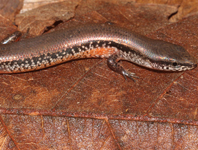Abstract
Biting midges, nematoceran flies family Ceratopogonidae, is represented by more than 6200 valid species. This group is still poorly known and not easy in identification. Structural coloration of insect wings (WIP, or Wing Interference Pattern) is an example of an optical phenomenon called iridescence, which is based on the formation of pigment-free, rainbow colours caused by the interference of white light reflected from transparent or semi-transparent structures. Preliminary results indicate that the structural colouring of the wings of these insects may be helpful in the delimitation of closely related and cryptic species.
References
Aguiar, A.P. (2012) A technique to dry mount Hymenoptera (Hexapoda) from alcohol in a few seconds, and its application to other insect orders. Zootaxa, 3412 (1), 53–61.
https://doi.org/10.11646/zootaxa.3412.1.3
Austen, E.E. (1909) New African phlebotomic Diptera in the British Museum (Natural History). Part. VI. The Annals and Magazine of Natural History; zoology, botany, and geology, Series 8, 3, 280–384.
https://doi.org/10.1080/00222930908692577
Austen, E.E. (1912) Notes on African blood-sucking midges (Family Chironomidae, Subfamily Ceratopogonidae), with descriptions of new species. Bulletin of Entomological Research, 3 (1), 99–108.
https://doi.org/10.1017/S0007485300001747
Berthier, S. (2007) Iridescences. The physical colors of insects. Springer Science+Media LLC, New York, x + 160 pp.
Beutel, R.G., Friedrich, F., Ge, S.-Q. & Yang, X.-K. (2014) Insect morphology and phylogeny. A textbook for students of entomology. Walter de Gruyter GmbH, Berlin/Boston, xv + 516 pp.
https://doi.org/10.1515/9783110264043
Borkent, A. & Dominiak, P. (2020) Catalog of the Biting Midges of the World (Diptera: Ceratopogonidae). Zootaxa, 4787 (1), 1–377.
https://doi.org/10.11646/zootaxa.4787.1.1
Buffington, M.L. & Sandler, R.J. (2011) The occurrence and phylogenetic implications of wing interference patterns (WIPs) in the Cynipoidea (Insecta: Hymenoptera). Invertebrate Systematics, 25 (6), 586–597.
https://doi.org/10.1071/IS11038
Butterworth, N., White, T.E., Byrne, P.G & Wallman, J.F. (2020) Love at first flight: Wing interference patterns are species-specific and sexually dimorphic in blowflies (Diptera: Calliphoridae). BioRxiv. [published online]
https://doi.org/10.1101/2020.02.18.948646
Carter, H.F., Ingram, A. & Macfie, J.W.S. (1920) Observations on the Ceratopogonidae midges of the Gold Coast with descriptions of new species. Part II. Annals of Tropical Medicine and Parasitology, 14 (2), 211–274.
https://doi.org/10.1080/00034983.1920.11684236
Chapman, R. (2013) The insects: structure and function. 5th Edition. Edited by Simpson, S. & Douglas, A. Cambridge University Press, Cambridge, xxxi + 929 pp.
https://doi.org/10.1017/CBO9781139035460
Combes, S.A. (2010) Materials, structure, and dynamics of insect wings as bioinspiration for MAVs. In: Blockley, R. & Shyy, W. (Eds.), Encyclopedia of aerospace engineering. Tome 7. John Wiley & Sons, Hoboken, New Jersey, pp. 1–9.
https://doi.org/10.1073/pnas.1017393108De Meillon, B. (1936) South African Ceratopogonidae. Part II. Some new and unrecorded species. Publications of the South African Institute for Medical Research, 38, 136–140.
De Meillon, B. (1937) Ceratopogonidae. 2. Records and species from South Africa. Publications of the South African Institute for Medical Research, 40, 332–385.
De Meillon, B. (1943) New records, and new species of Nematocera (Diptera) from the Ethiopian region. Journal of the Entomological Society of Southern Africa, 6, 90–113. [https://hdl.handle.net/10520/AJA00128789_3971]
Fiedler, O.G.H. (1951) The South African biting midges of the genus Culicoides (Ceratopogonidae, Dipt.). Onderstepoort Journal of Veterinary Research, 25, 3–33.
Foottit, R.G. &Adler, P.H (2018) Insect biodiversity: science and society. Vol. 1. 2nd Edition. Wiley-Blackwell, John Wiley & Sons, Hoboken, New Jersey, xxxi + 867 pp.
https://doi.org/10.1002/9781118945582
Foottit, R.G. & Adler, P.H (2019) Insect biodiversity: science and society, Volume 2. Wiley-Blackwell, John Wiley & Sons, Hoboken, NJ, xxxv + 987 pp.
Fox, I. (1948) Hoffmania, a new subgenus in Culicoides (Diptera: Ceratopogonidae). Proceedings of the Biological Society of Washington, 61, 21–28.
Fox, I. (1955) A catalogue of the bloodsucking midges of the Americas (Culicoides, Leptoconops and Lasiohelea) with keys to the subgenera and Nearctic species, a geographic index, and bibliography. The Journal of Agriculture of the University of Puerto Rico, 30, 214–285.
https://doi.org/10.46429/jaupr.v39i4.12674
Fusu, L. (2017) An integrative taxonomic study of European Eupelmus (Macroneura) (Hymenoptera: Chalcidoidea: Eupelmidae), with a molecular and cytogenetic analysis of Eupelmus (Macroneura) vesicularis: several species hiding under one name for 240 years. Zoological Journal of the Linnean Society, 181 (3), 519–603.
https://doi.org/10.1093/zoolinnean/zlw021
Gibb, T.J. (2015) Contemporary insect diagnostics. The art and science of practical entomology. Academic Press, Waltham, ix + 336 pp.
Gibb, T.J. & Oseto, C. (2019) Insect collection and identification. Techniques for the field and laboratory. 2nd Edition. Academic Press, Cambridge, Massachusetts, xiii + 339 pp.
Girault, A.A. (1913) New genera and species of chalcidoid Hymenoptera in the South Australia Museum, Adelaide. Transactions of the Royal Society of South Australia, 37, 67–115. [https://ia800208.us.archive.org/5/items/biostor-106154/biostor-106154.pdf]
Gorb, S.N. (2009) Functional surfaces in biology. Little structures with big effects. Springer, Dordrecht, XVIII + 384 pp.
https://doi.org/10.1007/978-1-4020-6697-9
Gordh, G. & Hall J. (1979) A Critical Point Drier used as a method of mounting insects from alcohol. Entomological News, 90 (1), 57–59.
Goureau, M. (1843) Sur l’irisation des ailes des insects. Annales de la Société entomologique de France, Series 2, 1, 201–215. [https://www.biodiversitylibrary.org/item/34167]
Gullan, P.J. & Cranston, P.S. (2014) The insects: an outline of entomology. Fifth edition, John Wiley & Sons, Ltd., West Sussex, 624 pp.
Hawkes, M.F., Duffy, E., Joag, R., Skeats, A., Radwan, J., Wedell, N., Sharma, M.D., Hosken, D.J. & Troscianko, J. (2019) Sexual selection drives the evolution of male wing interference patterns. Proceedings of the Royal Society B, 286, 20182850.
https://doi.org/10.1098/rspb.2018.2850Hosseini, F., Lotfalizadeh, H, Norouzi, M. & Dadpour, M. (2019) Wing interference colours in Eurytoma (Hymenoptera: Eurytomidae): variation in patterns among populations and sexes of five species. Systematics and Biodiversity, 17 (7), 679–689.


